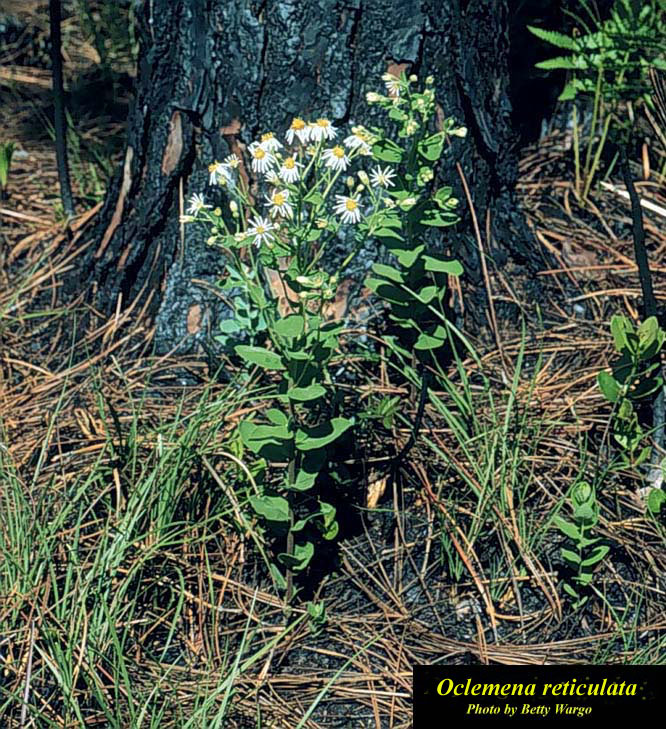Oclemena reticulata
| Oclemena reticulata | |
|---|---|

| |
| Photo by Betty Wargo, Atlas of Florida Vascular Plants | |
| Scientific classification | |
| Kingdom: | Plantae |
| Division: | Magnoliophyta - Flowering plants |
| Class: | Magnoliopsida – Dicotyledons |
| Order: | Asterales |
| Family: | Asteraceae ⁄ Compositae |
| Genus: | Oclemena |
| Species: | O. reticulata |
| Binomial name | |
| Oclemena reticulata (Pursh) G.L. Nesom | |

| |
| Natural range of Oclemena reticulata from USDA NRCS Plants Database. | |
Common name: pine barren whitetop aster
Contents
Taxonomic notes
Description
A description of Oclemena reticulata is provided in The Flora of North America.
It is distinct from other Oclemena by having tall erect stems, leaves with undulate margins, and late spring blooming [1].
Distribution
Distributed from South Carolina to Florida and southern Alabama[1].
Ecology
Habitat
O. reticulata can be found in areas that are occasionally inudated during the summer rainy season [2]. In the Coastal Plain in Florida and Georgia, habitats include wet pine flatwoods, pine/saw palmetto flatwoods, oak/palmetto scrubs, boggy wiregrass pine flatwoods, and ecotones between cypress swamps and pine flatwoods.It can be found in disturbed areas such as powerline corridors, cutover wet pinewoods and pasture edges. Soil types include loamy sand, sandy peat, and sandy loam (FSU Herbarium). Associated species include Sphagnum, Pinus serotina, Serenoa repens, Lyonia lucida, Rhynchospora, Cyperus haspan, C. strigosus, Eragrostis atrovirens, Ilex glabra, Lachnanthes caroliniana, Osmunda cinnamomea, Panicum abscisum, Pinus elliottii, Pteridium aquilinum, Rubus argutus, and Smilax laurifolia (FSU Herbarium; UF Herbarium).
Phenology
Flowers and fruits have been observed March through October (FSU Herbarium). It can spread by rhizomes and quickly form extensive colonies [2].
Seed dispersal
Seed bank and germination
Fire ecology
It has been observed growing in prescribed burned wet flatwoods and a burn zone in mesic flatwoods (UF Herbarium).
Pollination
The following Hymenoptera families and species were observed visiting flowers of Oclemena reticulata at Archbold Biological Station (Deyrup 2015):
Apidae: Apis mellifera
Megachilidae: Dianthidium floridiense
Use by animals
Diseases and parasites
Conservation and Management
Cultivation and restoration
Photo Gallery
Flowers of Oclemena reticulata Photo by Wayne Matchett, SpaceCoastWildflowers.com
References and notes
Deyrup, M.A. and N.D. 2015. Database of observations of Hymenoptera visitations to flowers of plants on Archbold Biological Station, Florida, USA.
Florida State University Robert K. Godfrey Herbarium database. URL: http://herbarium.bio.fsu.edu. Last accessed: October 2015. Collectors: Loran C. Anderson, Andre F. Clewell, George R. Cooley, R.F. Doren, Bob Fewster, A. Gholson Jr., R.K. Godfrey, Norlan C. Henderson, S.C. Hood, C. Jackson, Nancy E. Jordan, M. Knott, R. Komarek, Robert Kral, S.W. Leonard, Sidney McDaniel, Marc Minno, Grady W. Reinert, J. Semple, Cecil R. Slaughter, Joe Sparling, L.B. Trott, Kenneth A. Wilson, Carroll E. Wood. States and Counties: Florida: Bradford, Calhoun, Clay, Columbia, Duval, Flagler, Franklin, Gulf, Hamilton, Hardee, Hernando, Highlands, Hillsborough, Holmes, Jackson, Lake, Leon, Liberty, Nassau, Orange, Osceola, Pasco, Pinellas, Polk, Putnam, St. Johns, Taylor, Union, Wakulla, Walton. Georgia: Thomas. Compiled by Tall Timbers Research Station and Land Conservancy.
